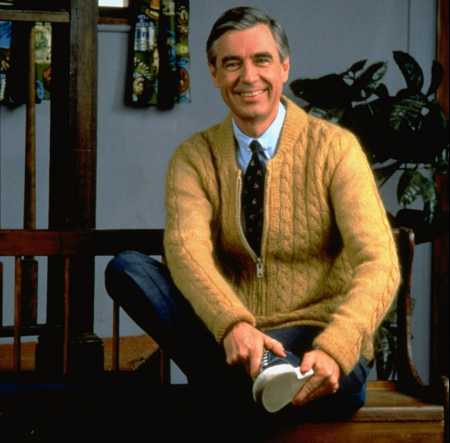It was always a beautiful day in Mister Rogers’ Neighborhood, as Mister Rogers entered his TV set house singing the show’s theme song, “Won’t you be my neighbor?” He would hang up his coat and put on his cardigan sweater, take off his shoes and put on his sneakers, and settle in to talk directly to his young viewers.
Debuting on the National Educational Television network (the predecessor to PBS) in 1968, Mister Rogers’ Neighborhood was the longest-running series in PBS history when it went off the air in 2001 (though its record was later surpassed by Sesame Street). With his gentle and calming manner, Fred Rogers entertained, educated, and reassured several generations of preschoolers, becoming one of the most beloved and iconic figures on television. His sweater even ended up in the Smithsonian Museum.
Like its host, the show was characterized by its quiet simplicity and gentle pace. Mister Rogers would talk to his viewers about all sorts of issues that might be on their minds, from fears about going to sleep or going to the doctor, to disappointment about not getting one’s way, to experiencing the death of a loved one. He would sometimes take viewers on visits to shops and factories in his “neighborhood,” demonstrate crafts or experiments, sing songs or listen to music, and interact with a cast of guests and regular characters, including delivery man Mr. McFeely, Neighbor Aber, Lady Aberlin, Chef Brockett, Officer Clemmons, Mrs. McFeely, Handy Man Negri, and Emily the Poetry Lady.
At the start of each show, a little scale-model trolley was seen chugging along a track through the neighborhood. The little trolley would reappear later in the show to indicate the transition from the realistic world to the fantasy world of the Neighborhood of Make-Believe, which was populated by puppet characters like King Friday the Thirteenth, Lady Elaine Fairchild and Daniel Striped Tiger. Mister Rogers would usually talk explicitly about this transition, sometimes telling the audience what was going to happen and making it clear that it was all make-believe. This clear delineation between reality and fantasy contrasted with other PBS children’s shows like Sesame Street, where realistic and imaginary elements seamlessly blended together.
The jazz-inspired piano music on the show was also notable. Played live during each program’s taping, It had a lovely simplicity and flow that accompanied and harmonized with the sketches, almost like another character on the show. The piano was also heard during the many songs that Fred Rogers performed on the program, with lyrics that he wrote himself.
Mister Rogers’ Neighborhood didn’t talk down to its young viewers, and the series addressed some difficult issues over the years, like competition, divorce, illness, and war. On more than a few occasions, Rogers talked about anger and how to handle angry feelings without hurting others. One of the most famous episodes in the series was broadcast in March 1970, when Rogers talked about the death of his pet goldfish. In November 1983, when ABC showed the futuristic made-for-TV movie The Day After, which dramatized the aftermath of a nuclear war, Mister Rogers aired a week-long series of episodes about war, bombs, and the arms race, designed to help children cope with the after-effects of the TV movie.
You can see more of Mister Rogers on these DVDs: Fred Rogers — America’s Favorite Neighbor (2005), Mister Rogers’ Neighborhood — A Day at the Circus, Mister Rogers’ Neighborhood — Adventures in Friendship, Mister Rogers’ Neighborhood — Going to School, and Mister Rogers’ Neighborhood: What Do You Do with the Mad that You Feel? You might also be interested in these books by Fred Rogers: You Are Special: Neighborly Wisdom from Mister Rogers andThe World According to Mister Rogers.


Recent Comments